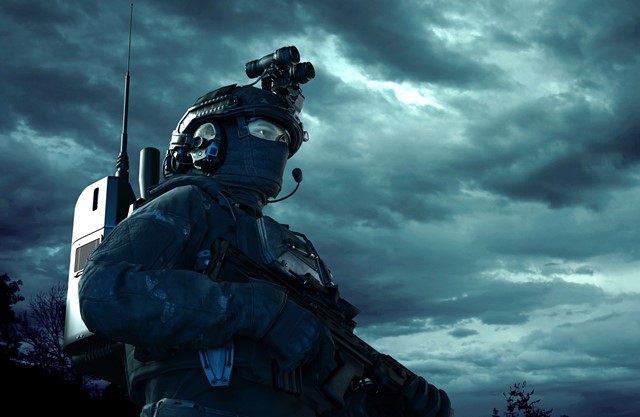Building an unmanned army: the end of the soldier?
 It is no secret that technology has played a key role in the military for centuries, from siege engines used by the Roman army, to the latest modern-day unmanned vehicles. What’s more, our reliance and use of technology shows no sign of stopping as the demands of the modern battlefield stimulates new challenges requiring a new wave of innovations that are set to change the traditional role of the soldier.
It is no secret that technology has played a key role in the military for centuries, from siege engines used by the Roman army, to the latest modern-day unmanned vehicles. What’s more, our reliance and use of technology shows no sign of stopping as the demands of the modern battlefield stimulates new challenges requiring a new wave of innovations that are set to change the traditional role of the soldier.
At the same time, the UK MoD is under increasing pressure to reduce costs alongside plans to dramatically reduce the number of regular soldiers. Media and public opinion adds to this pressure by demanding casualties are reduced and soldiers are better equipped, and where possible, removed from the highest threat environments altogether.
A view of the modern-day battlefield
Modern warfare is extremely complex. Battlefields may contain several enemy factions which are each allied to a range of different, overlapping and conflicting causes. Some enemy factions are well-funded, organised, with access to modern weaponry but are prepared to use unconventional tactics. The majority of warfare now takes place in densely populated urban environments, leaving soldiers highly vulnerable to close-range attack from all directions. These urban environments can be populated with thousands of civilian inhabitants. This risk of civilian casualties means soldiers are restricted in the methods they can use to defeat enemy forces.
These modern conditions therefore require new technologies and concepts of operation to protect our soldiers, with one suggested approach being to use drones and robots in place of them.
Unmanned and autonomous systems
Soldiers are now able to investigate these high threat urban environments remotely through the use of unmanned systems. Unmanned systems relay video information in real-time back to the front-line soldier or commander, allowing them to make informed decisions about an area, removing the risk to life of any colleagues. Each year these systems are getting smaller, with some current unmanned aerial systems weighing less than two pound coins.
A further advantage of unmanned systems is that they could be designed to be exempt from the same physical limitations as humans. Soldiers can be expected to operate in temperatures ranging from 50°C to below freezing during the course of a single day and expected to carry in excess of 40 kg of equipment that severely hampers their maneuverability, agility and the distance they can cover. Future developments may mean that robotic systems can be designed to carry heavy loads and cover great distances over all terrain types in all weather conditions without requiring regular periods of rest.
Unfortunately, unmanned systems do not come without a number of challenges. What happens if one malfunctions or becomes damaged during an operation? It could fall into enemy hands, allowing them to uncover sensitive information that could put future operations at risk, therefore technology must be created to minimise this risk as much as possible.
An algorithm has been created by computer scientists which allows a six-legged robot to rapidly adjust its motion in order to cope with damage, such as the loss of a limb or foot. Similar innovative approaches will also be required to permit remote systems to degrade gracefully when damaged and recover themselves to a safe location (even with catastrophic failure to many sub-systems) .
Artificial Intelligence
The next logical step in the evolution of unmanned technology is to equip unmanned systems with artificial intelligence that can plan missions (given a set of high-level objectives), autonomously search an area and choose the key pieces of information required to make an informed decision and transmit only that back to the person in charge. Not only would this significantly reduce the burden on human operators, who would otherwise be planning missions, piloting vehicles and monitoring raw sensor data but it could also free up operators for other tasks or enable multiple unmanned systems to be managed by a single person.
We must remember however, the importance of ensuring these advancements are as fail-proof as possible. The soldiers working with these autonomous systems must have appropriate trust in the decisions they make and the information they provide. This must be built up over time, as any AI needs to prove it can make correct decisions in a range of complex scenarios. This will take time and the transition to fully autonomous systems will therefore be incremental and gradual rather than a complete overnight step-change.
Future developments and their risks
Future developments in technology could mean that artificial intelligence has the capability to autonomously select and engage with targets reliably without human input (the technical term being “Lethal Automated Weapons Systems” or LAWS). However, this will naturally cause various moral dilemmas with the question of whether a machine should be given the power of life and death over humans? Current regulations enforced by the UK MoD require a human operator to always be part of the decision making process in order to fire a weapon. Due to ongoing progress in this type of technology however, the likelihood is that the autonomous technology necessary to target and deliver a lethal effect will arrive before the regulations that allow it. This could mean that our foes will be using such technology first, as they won’t necessarily be concerned about international law and such ethical considerations.
Given the time it takes for the military to procure a system, and the pace of development of autonomous systems technology in the consumer market, we may find that the army lags behind the consumer. A determined and modestly funded foe could soon equip themselves with autonomous systems whose capability rivals or exceeds our own army’s, with the potential to lead to the prospect of drone versus drone battles.
So will the latest technology really replace frontline soldiers?
It’s fair to say that soldiers will be increasingly augmented, rather than replaced, by autonomous systems over the coming years. Although autonomous systems and robotics will limit casualties and provide better protection and situational awareness, a soldier will always be required in the decision making process. Furthermore, soldiers go beyond providing military force to repel and defeat enemies, they also play a vital role in delivering aid, re-building destroyed infrastructure, training friendly local forces and providing peacekeeping.
Although there are many advantages to be gleaned from unmanned and autonomous systems, we must always be vigilant as to how the same systems could be used by our enemies against us.
This article summarises Plextek’s vision paper ‘Are the days of the solider numbered?” which takes a closer look at whether unmanned and autonomous technology could mark the end of the soldier as we know it.













